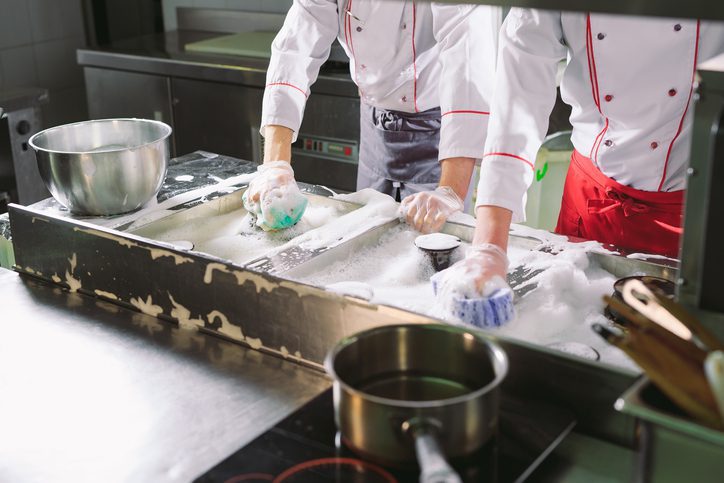Tips for Maintaining a Clean and Hygienic Restaurant
Maintaining a clean and hygienic restaurant is essential for ensuring the health and safety of your customers and staff. A spotless environment not only promotes customer satisfaction but also helps you comply with health regulations and avoid costly fines. Here are some valuable tips to keep your restaurant in top-notch condition.
1. Develop a Cleaning Schedule
A structured cleaning schedule ensures that every part of your restaurant is cleaned regularly. Divide tasks into daily, weekly, and monthly categories to maintain a thorough and consistent cleaning routine.
Daily Tasks
Daily tasks should include:
- Wiping down tables and chairs
- Cleaning and sanitizing restrooms
- Sweeping and mopping floors
- Sanitizing kitchen surfaces, including countertops and cutting boards
- Cleaning cooking equipment after each use
Ensuring that each shift completes their cleaning duties before turnover is crucial. This not only helps in maintaining a spotless environment but also ensures that the next team starts with a clean slate, promoting a continuous cycle of cleanliness throughout the day.
Weekly Tasks
Weekly tasks might involve:
- Deep cleaning kitchen appliances such as ovens, fryers, and refrigerators
- Checking for expired food items and disposing of them appropriately
- Cleaning windows and glass surfaces
- Washing and sanitizing trash cans
Monthly Tasks
Monthly tasks can include:
- Detailed cleaning of ventilation systems to remove grease and dust buildup
- Cleaning behind heavy equipment like stoves and refrigerators
- Inspecting and cleaning light fixtures and ceiling fans
- Polishing floors and furniture
By breaking down tasks into manageable categories, you can ensure that every area of your restaurant receives the attention it needs without overwhelming your staff.
2. Train Your Staff
Proper training is crucial for maintaining high hygiene standards. Ensure all staff members understand the importance of cleanliness and know how to use cleaning products correctly.
Initial Training
New hires should undergo comprehensive training that covers:
- The restaurant’s cleaning schedule and the specific tasks for each shift
- Proper usage and storage of cleaning products
- Techniques for effective cleaning and sanitization
- Importance of personal hygiene, including regular hand washing and wearing clean uniforms
Ongoing Training
Regularly update training programs to incorporate new health regulations and cleaning techniques. Conduct refresher courses and training sessions to keep all staff members up-to-date with the latest standards and practices.
Emphasize Shift Responsibilities
Each shift must finish what they start, including their cleaning tasks. This means ensuring that all cleaning duties are completed before the end of their shift. By doing so, you can ensure a seamless transition between shifts and maintain a consistently clean environment. This approach fosters accountability and ensures that no tasks are left unfinished, which could compromise the overall cleanliness of the restaurant.
Personal Hygiene
Emphasize the importance of personal hygiene among staff members:
- Regular hand washing with soap and water, especially after handling food or using the restroom
- Wearing clean uniforms and hairnets or caps to prevent contamination
- Using gloves when necessary, particularly when handling ready-to-eat foods
3. Use the Right Cleaning Products
Using appropriate cleaning products is essential for effective sanitation in your restaurant. Choosing the right products not only ensures effective cleaning but also protects your staff and the environment.
Eco-Friendly Options
Opt for eco-friendly products that are biodegradable and free from harsh chemicals. These products are safer for your staff to handle and reduce the environmental impact. For example, plant-based cleaners can be just as effective as their chemical counterparts without the associated risks.
Specialized Cleaners
Different areas of your restaurant require specific types of cleaners:
- Degreasers: Essential for the kitchen, degreasers effectively break down grease and oil on surfaces such as stovetops, ovens, and grills. This helps prevent buildup that can lead to fire hazards and poor sanitation.
- Disinfectants: Use disinfectants in restrooms and dining areas to kill germs and bacteria. Ensure that these products meet health department standards for sanitation.
- Glass Cleaners: Keep windows, glass doors, and display cases spotless with specialized glass cleaners that leave surfaces streak-free.
Proper Use and Storage
Always follow the manufacturer’s instructions for using and storing cleaning products. Correct usage ensures the maximum effectiveness of the product, while proper storage prevents accidents and maintains product integrity. Make sure your staff is trained on how to handle these products safely, including wearing protective gear when necessary.
4. Focus on High-Touch Areas
High-touch areas like door handles, menus, and payment terminals are hotspots for germs and bacteria. Cleaning and disinfecting these areas frequently is crucial to prevent the spread of illnesses.
Frequent Cleaning
High-touch surfaces should be cleaned and disinfected multiple times throughout the day. Create a checklist for staff to ensure these tasks are completed regularly. Areas to focus on include:
- Door handles and push plates: These are touched by almost everyone entering or leaving the restaurant.
- Menus: Consider using disposable menus or digital ordering systems to minimize contact. If using reusable menus, sanitize them after each use.
- Payment terminals: Wipe down terminals after each use with disinfectant wipes.
Additional Measures
- Antimicrobial Coatings: Consider applying antimicrobial coatings to high-touch surfaces. These coatings provide an extra layer of protection by continuously killing germs on contact.
- Hand Sanitizer Stations: Place hand sanitizer stations near high-touch areas to encourage customers and staff to sanitize their hands frequently.
5. Maintain Kitchen Cleanliness
The kitchen is the heart of your restaurant, and keeping it clean is vital to ensure food safety and a healthy working environment.
Regular Sanitization
All surfaces, utensils, and equipment should be sanitized regularly. Implement a “clean as you go” policy where staff clean their workstations and utensils immediately after use. This practice helps prevent the buildup of dirt and reduces the risk of cross-contamination.
Proper Food Storage
Store food items properly to prevent contamination. This includes:
- Keeping raw and cooked foods separate to avoid cross-contamination.
- Storing perishable items at the correct temperatures to prevent bacterial growth.
- Using airtight containers to keep food fresh and protect it from pests.
Routine Checks
Regularly check for and discard expired goods. This practice not only ensures that your customers receive fresh food but also helps prevent foodborne illnesses. Additionally, conduct routine inspections of your kitchen to identify and address any sanitation issues promptly.
Floor and Drain Cleaning
Clean kitchen floors and drains daily to prevent the buildup of grease and food particles that can attract pests. Use specialized floor cleaners and degreasers to maintain a safe and hygienic environment.
Staff Training
Ensure your kitchen staff is trained in proper cleaning techniques and the importance of maintaining a clean workspace. Regularly review and update your cleaning protocols to incorporate new health regulations and best practices.
6. Regularly Clean Restrooms
Restrooms are a reflection of your overall hygiene standards, and maintaining their cleanliness is critical for customer satisfaction and health compliance.
Frequent Cleaning
Clean and disinfect restrooms multiple times a day. High-traffic times, such as during meal service hours, should see increased cleaning frequency. Assign staff members specific times and tasks to ensure that restrooms are always clean and sanitary.
Stocking Essentials
Ensure restrooms are always stocked with essential supplies such as soap, paper towels, and toilet paper. Check these supplies frequently throughout the day and replenish as necessary. Consider using automatic dispensers to reduce contact and the spread of germs.
Plumbing and Maintenance
Regularly inspect plumbing to identify and address issues promptly. Fix leaky faucets, running toilets, and any other plumbing problems that could lead to unpleasant odors or water damage. Ensure that fixtures are functioning properly and that the restroom remains dry and clean.
Odor Control
Implement odor control measures such as air fresheners or odor-neutralizing sprays. Ensure proper ventilation in restrooms to keep the air fresh. Regular cleaning and maintenance can prevent odors from becoming a problem.
Deep Cleaning
Schedule deep cleaning sessions for restrooms at least once a week. This should include scrubbing floors, walls, and fixtures, as well as cleaning and sanitizing areas that are not addressed during daily cleanings, such as behind toilets and under sinks.
7. Manage Waste Effectively
Proper waste management is crucial for maintaining a clean restaurant environment and preventing health hazards.
Use of Bins
Use bins with tight-fitting lids to prevent pests and contain odors. Place bins in strategic locations throughout the restaurant, including the kitchen, dining area, and restrooms. Ensure bins are easily accessible to staff but out of sight for customers.
Regular Emptying
Empty bins regularly, especially those in high-use areas like the kitchen and restrooms. Overflowing bins can attract pests and create unsanitary conditions. Implement a schedule for waste collection to ensure bins are emptied before they become too full.
Waste Separation
Separate recyclable and non-recyclable waste to ensure proper disposal. Provide clearly labeled bins for different types of waste, such as glass, plastic, paper, and general waste. Educate your staff on the importance of waste separation and proper disposal methods.
Hazardous Waste
Properly dispose of hazardous waste, such as cleaning chemicals and used cooking oil, according to local regulations. Use designated containers for hazardous materials and arrange for regular pick-ups by licensed waste management companies.
8. Pest Control
Pests can severely damage your restaurant’s reputation and pose significant health risks. Implement a comprehensive pest control plan to keep your restaurant pest-free.
Regular Inspections
Conduct regular inspections of your restaurant to identify signs of pest activity. Check common entry points, such as doors, windows, and vents, and inspect areas where food is stored and prepared. Look for signs of pests, such as droppings, nests, and gnaw marks.
Waste Management
Proper waste management is crucial for pest control. Ensure that all waste is stored in bins with tight-fitting lids and is disposed of regularly. Clean waste storage areas frequently to remove food debris and odors that can attract pests.
Sealing Entry Points
Seal any gaps, cracks, or holes where pests could enter your restaurant. Use weather stripping on doors and windows, and install door sweeps to prevent pests from entering through gaps under doors. Ensure that screens on windows and vents are intact and free of holes.
Professional Pest Control
If necessary, hire a professional pest control service to handle infestations. Regularly schedule visits from pest control experts to conduct thorough inspections and treatments. A professional service can provide effective and safe solutions to keep your restaurant pest-free.
9. Ventilation and Air Quality
Good ventilation is important for maintaining a fresh and odor-free environment, ensuring the comfort and health of both customers and staff.
Ventilation Systems
Ensure your ventilation systems are cleaned and maintained regularly. Clean air ducts and filters to remove dust, grease, and other contaminants that can reduce air quality. Regular maintenance helps your ventilation system operate efficiently and effectively.
Air Purifiers
Consider using air purifiers to improve indoor air quality. Air purifiers can help reduce airborne contaminants, such as dust, pollen, and bacteria, creating a healthier environment for everyone in the restaurant. Place air purifiers in high-traffic areas and near cooking and preparation areas.
Proper Airflow
Ensure proper airflow throughout the restaurant by keeping vents unobstructed and using fans to circulate air. Good airflow helps prevent the buildup of odors and maintains a comfortable temperature for customers and staff.
Kitchen Ventilation
Pay special attention to kitchen ventilation. Use range hoods and exhaust fans to remove smoke, steam, and cooking odors. Regularly clean and maintain kitchen ventilation equipment to ensure it operates effectively and safely.
10. Customer Feedback
Encouraging customer feedback on your cleanliness standards is vital for continuous improvement and demonstrating your commitment to hygiene.
Feedback Channels
Provide multiple channels for customers to give feedback, such as comment cards, online surveys, and social media platforms. Make it easy for customers to share their thoughts and experiences.
Address Complaints Promptly
Take all feedback seriously, especially complaints about cleanliness. Address any issues promptly and make necessary improvements to your cleaning practices. Responding to feedback shows customers that you value their opinions and are committed to maintaining high standards.
Use Feedback for Improvement
Use customer feedback to identify areas that need improvement. Regularly review feedback and discuss it with your staff to implement changes and enhance your cleaning practices. Positive feedback can also be shared with your team to recognize their efforts and motivate them to maintain high standards.
Transparency
Be transparent about your cleaning practices. Share information about your cleaning schedule, the products you use, and your commitment to hygiene on your website and social media. Transparency builds trust with your customers and reassures them that their health and safety are your top priorities.
Maintaining a clean and hygienic restaurant requires dedication and a proactive approach. By developing a comprehensive cleaning schedule, training your staff, using the right cleaning products, and focusing on high-touch areas, you can ensure your restaurant remains a safe and inviting place for customers and staff alike. Remember, a clean restaurant is not only essential for health and safety but also for building a strong reputation and ensuring the success of your business. For professional assistance in keeping your commercial and office spaces spotless, trust Good Cleaner Co. to deliver exceptional commercial and office cleaning services tailored to your needs. Our experienced team is committed to providing top-notch cleanliness, ensuring your business environment is always at its best.





